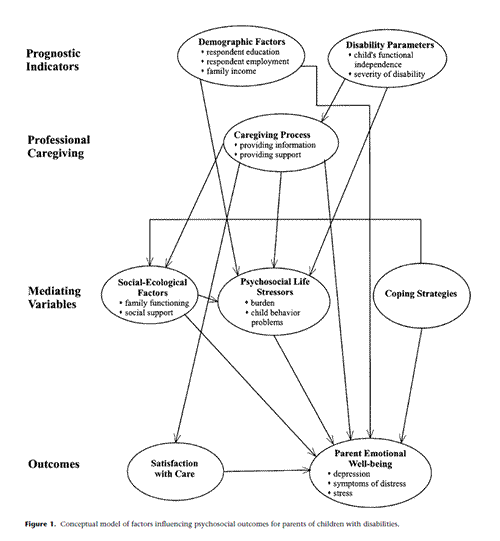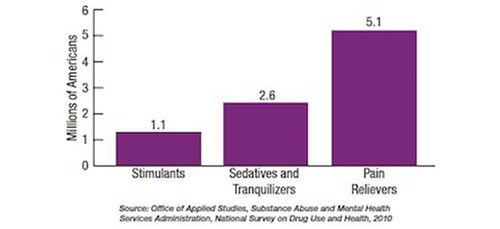Drug Abuse Among People with Disabilities
written by Brianna
Aldridge, Undergraduate Student, University of Florida
 Not
infrequently, people with disabilities receive some form of
medication prescribed by their physician with the intent being
to assuage pain. This is a natural route for a person with
a disability, seeing as they more likely than not will experience
some form of pain (be it physical, mental, or emotional) on
a regular basis. However, an issue arises when the drugs that
an individual takes become abused. Not
infrequently, people with disabilities receive some form of
medication prescribed by their physician with the intent being
to assuage pain. This is a natural route for a person with
a disability, seeing as they more likely than not will experience
some form of pain (be it physical, mental, or emotional) on
a regular basis. However, an issue arises when the drugs that
an individual takes become abused.
The adverse effects of drug abuse produce countless consequences
for those who abuse them, disabled or not. As such, research
has been conducted that attempts to determine the background
behind abuse as well as factors that play some type of role.
When disabled youth become the focus of this discussion, a
new realm of possible outcomes arises. How are the social
relationships of disabled children and their peers affected?
How do parents and teachers deal with situations stemming
from differences among students? What is the role of a health
educator or exercise therapist in this population?
This particular paper will discuss drug abuse among people
with disabilities. In a more general sense, it will discuss
disabilities of individuals in the adolescent stage of life.
Results of research will show the examination of the characteristics
of drug abuse and its prevalence in both the overall population
and the youth cohort. It will place a scope on drug abuse
in these disabled populations and briefly mention preventive
measures. Furthermore, this paper will expose the recurring
fact that there is limited research in and around this topic.
As such, the conclusion will attempt to explain what can be
done in response, and why changes should be implemented. Throughout
the paper, exercise therapy techniques will be mentioned and
validated.
Before drug abuse in a certain population can be discussed,
it is crucial to understand the characteristics of drug abuse
in general. According to the National Institute on Drug Abuse,
drug abuse occurs when drugs are consumed for a purpose not
intended by the physician ("Prescription and over-the-counter,"
2012). Prescription drug abuse is perceived to be the most
common form of drug abuse among people with disabilities,
seeing as their physician typically prescribes them medicine.
In addition, this type of abuse is most common in young people,
which correlates with the population we have discussed for
the majority of this course. Abuse of most drugs, including
prescription, is characterized by an increase in the amount
of pleasure the body feels. When drugs are used, neurotransmitters
(typically dopamine) are stimulated to bring pleasure. To
continue to feel that pleasure, an individual may use the
drug more than was intended by their physician. A person with
disabilities abusing drugs increases their chances of experiencing
harm and adverse effects.
The Department of Health Education and Behavior at the University
of Florida offers a course titled: Exercise Therapy, Adapted
Physical Activity and Health. The course discusses multiple
forms of disability, be it physical or mental. Another major
component of the course focused on the well-being of individuals
afflicted with a disability as well as the people around them.
In a home or school setting, parents and teachers become the
primary recipients of stress, uncertainty and overall hardship
in regard to these particular children and students. Are there
available coping mechanisms? Perhaps a guide to working with
a child with a disability?
According to one study, professional caregiving services
that focus on the family holistically are the greatest assets
to stress alleviation in parents (King, King, Rosenbaum &
Goffin, 1999). Parents responded positively to valid solutions
that can help them and their children equally. Figure
1 expounds upon the factors that enhance parental distress
and other psychosocial behaviors. Another group of researchers
consider parent to parent self-help groups as a viable and
effective method for dealing with their offspring who have
disabilities (Singer, Marquis, Powers, Blanchard, Divenere,
Santelli, Ainbinder & Sharp, 1999). These methods provide
exceptional comprehensive solutions to parents regarding the
issue of having a child with disabilities.
In the classroom, though, various situations can arise, many
of which do not equate to home situations. As such, teachers
have offered insight into their world when faced with the
challenge of training up students who have disabilities. Their
responses were recorded in a journal titled Exceptional Children.
What can be gathered from this body of work is a plethora
of "transforming experiences" (Giangreco, Dennis,
Cloninger, Edelman & Schattman, 1993). Teachers who initially
only accepted a student with disabilities into their classroom
based on the level of support that would be received (i.e.
technical assistance, increased attention to the class, etc.)
reversed their mindset after experiencing the child in the
classroom. The transformation was not nor was it expected
to be immediate. Rather, after two years transpired, educators
began to recognize the student with disabilities on the same
level as the other students. They cited efforts like challenging
themselves, increasing expectations and responsibility levels,
and having an overall sincere feeling of devotion towards
their student.
It should be stated that the aforementioned studies provide
implications for exercise therapy procedures for these youth
with disabilities. As stated earlier, the course offered under
the Department of Health Education and Behavior focuses on
numerous therapeutic opportunities all involving exercise.
Though the studies just discussed do not mention exercise
as a form of coping or creating a positive attitude, there
is no question that exercise will do just that. Placing children
with disabilities in an arena where they can be physically
active (i.e. be just like a "normal kid") prove
to be outlets of joy and self-expression. Parents and teachers
receive the chance to engage with their child or student on
a level that is not intellectual but just as crucial to effective
development.
Figure 1

Source: Journal of Pediatric Psychology
Scholars have found that drug abuse is present among those
with mental illness, but there is little research beyond that
to organize prevention methods or even construct in-depth
research articles. LeeAnn Christian and Alan Poling published
an article discussing a few research findings. They noted
that drug abuse among people suffering from mental retardation
occurs at a lower rate than for people who do not suffer from
mental retardation (Christian & Poling, 1997). Nevertheless,
level of harm for people with mental disabilities can be more
severe.
Another study that was reviewed mentioned that only a small
dosage of a prescribed drug might produce adverse effects
when paired with alcohol or other drugs. An interesting point
made in Christian and Poling's research stated that the same
risk factors of drug abuse for a person without a disability
(family history, age at which abuse began, etc.) are evident
in people with a disability. Though the authors of this article
desire to confer with readers as to what types of treatment
and/or prevention are available, the unfortunate reality is
that a problem has not really been identified, as noted by
Phillips and Johnson in their review about the development
of drug abuse among those afflicted with psychotic illness
(Phillips & Johnson, 2001). A possible explanation is
that many believe that individuals with mental retardation
do not drink or have access to drugs (Christian and Poling,
1997). The ultimate goal that many researchers like these
share is to obtain more evidence on what can be done for people
suffering from mental illness.
Though published prevention methods for drug abusers who
have disabilities are sparse, the numbers showing abuse of
certain drugs in general is staggering, as shown in Figure
2. Nonetheless, there are some ideas as to what can be done
to assist the drug abusers of the disabled population. An
article in the Multiple Sclerosis Journal talks about drug
abuse among people suffering from multiple sclerosis. Their
form of research tackled many facets of MS in a specific community,
ranging from interest in change to disease severity. The results
after testing showed that between 14 and 19 percent of the
community abused or misused drugs in the span of a month.
With this data, ideas for prevention arose. These ideas included
substance abuse screening and counsel on reducing or entirely
cutting off drug intake (Bombardier, Blake, Ehde, Gibbons,
Moore & Kraft, 2004). Published ideas on this topic produce
a step in the right direction towards published articles on
prevention. As students and researchers alike await progress,
there are other possibilities. Preventive measures can be
furthered with medically managed care.
Figure 2

Source: National Institute on Drug Abuse
Medical care for people with disabilities is highly utilized.
The same can be said for disabled individuals who have succumbed
to drug abuse. Adverse effects of drug abuse revolve around
withdrawal: physiological setbacks, social consequences, and
economic disparity. In regards to physiological setbacks,
Medicaid managed care has come into play. Though utilitarian,
there are multiple factors to consider before drug abusers
with disabilities receive Medicaid. A group of researchers
(Bachman, Drainoni & Tobias, 2004) reported on literature
that stated that medical services are not ever-present for
drug abusers with disabilities. However, drug abusers with
disabilities are more likely to receive health benefits and
monetary support from Supplemental Security Income (SSI),
a federally funded means of assistance. Because of this likelihood,
the chances for receipt of Medicaid managed care increase.
Despite the possibilities, Medicaid for this group of people
comes at a dauntingly high expense. The major issue regarding
the topic of Medicaid managed care for these individuals is
the lack of published literature available for researchers.
As such, Bachman and colleagues concluded that there are multiple
routes to take when furthering documentation of care for the
affected population. One form of care that has substantial
documentation is exercise therapy.
With the perceived and actual repercussions of drug abuse,
some form of therapy must be implemented to begin the healing
process. Exercise therapy is the key to physical, mental and
emotional rehabilitation for people with disabilities. The
Adapted Physical Activity course has explained in depth the
numerous ways in which exercise can be utilized in populations
of people with disabilities. Researchers have claimed, "The
process of exercising, via the provision of distraction and
social interaction rather than the exercise itself" is
what makes this form of therapy so effective (Faulkner &
Sparkes, 1999). The confidence and inner strength that can
be established through exercise therapy is a testament to
its greatness.
Putting a person with a disability in a situation where they
must physically work to create an outcome gives them autonomy,
as well as the notion that pity is not desired nor warranted.
Exercise is also a fantastic outlet for drug abusers, as withdrawal
periods can be combated with the introduction of exercise
into the daily routine. There are no limits to the equipment
that can be used, or the methods that can be performed. Because
drug abuse does indeed occur among people with disabilities,
it would be ideal for more research to be available that describes
exercise therapy as a form of rehabilitation.
The facts of drug abuse are highly documented, as are the
general methods of care for people with disabilities. A positive
outlook on this topic comes from parents and teachers who
feel their child or student is performing at an adequate level.
They report receiving support, feeling minimal levels of stress,
and wholly responding confidently to the children who have
disabilities. Unfortunately, the research that has been presented
tackling the topic of drug abuse among people with disabilities
is scarce. As a result, literature reviews contain research
coupled with speculation and assumptions.
It is clear that there needs to be concrete solutions to
aid in the prevention of drug misuse and abuse, but first,
the discussion much reach multiple areas. Until this occurs
and more research is published, health educators and other
interested parties will be forced to make decisions based
on good judgment and limited professional assistance. Despite
these challenges, there is no doubt that researchers are trying
to shine a brighter light on drug abuse among people with
disabilities, both its prevalence and how to manage it. Health
educators desire to have a broader understanding on the topic
in order to manage patients more efficiently. Students yearn
to enter into a field where they can be the primary agents
of change and progression. Because of these wants, strides
are being made in this area of health education, and with
collaborative efforts, there will eventually be a plethora
of literature reviews tackling every area of this topic.
REFERENCES
(back
to pelinks4u homepage) |




 Not
infrequently, people with disabilities receive some form of
medication prescribed by their physician with the intent being
to assuage pain. This is a natural route for a person with
a disability, seeing as they more likely than not will experience
some form of pain (be it physical, mental, or emotional) on
a regular basis. However, an issue arises when the drugs that
an individual takes become abused.
Not
infrequently, people with disabilities receive some form of
medication prescribed by their physician with the intent being
to assuage pain. This is a natural route for a person with
a disability, seeing as they more likely than not will experience
some form of pain (be it physical, mental, or emotional) on
a regular basis. However, an issue arises when the drugs that
an individual takes become abused. 
